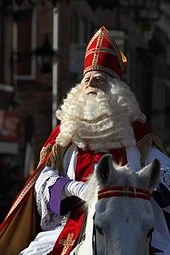As some of you know, my wife and I spent several of the first years of our marriage in Amsterdam, the Netherlands. Our two older sons were born there, and although they were very young when we moved to French-speaking Switzerland, we have continued certain Dutch traditions, as well as keeping Dutch as our "secret language", to honor our time spent there.
Tonight, thousands of Dutch, Belgian, and northern French families are celebrating Sinterklaasdag, or St. Nicholas Day. December 6 is the name day of a real historical character, Nicholas, Bishop of Myra, who lived in 4th century Asia Minor (now Turkey). He was known as a kind and generous man with a heart for children, and thus is considered the patron saint of children.
Sinterklaas is the Dutch take on this character, who inspired the Christmas icon we anglophones call Santa Claus. The kindly old man traditionally arrives by boat at a different port in mid- to late November, supposedly from Spain. There are various theories on why Spain; in any case, Sinterklaas is accompanied by several helpers, collectively known as
Zwartepiet (Black Pete). These characters have traditionally been played by white people in blackface portraying Moors, the North Africans who invaded and occupied Spain for centuries. Black the Moors were not; and in recent years, as in the US, the blackface has come to be perceived as racist. So some Zwartepiets now just smudge their faces with a little coal to represent the soot from their duties delivering gifts down chimneys.
Sinterklaas on his steed
On the eve of December 6, some children leave their shoes (traditionally wooden clogs) next to the fireplace, sometimes stuffed with a carrot or hay for Sinterklaas' horse. It is then the parents' job to "surprise" the kids with treats in the shoes the next morning.
Most gifts are actually exchanged on Sinterklaasdag rather than on Christmas Day, as that date is dedicated primarily to celebrating, of all things, the birth of Jesus. But in recent years, some adults have taken to the tradition of waiting till Christmas Day to do the gift exchange. But gifts given on Sinterklaasdag are often accompanied by a poem, or perhaps a note explaining the choice of gift.
This year my wife and I decided to try our hand at baking gevulden koeken, or filled almond cookies, for the first time. The results were not too shabby, so we wrapped those up along with some other Dutch treats for our three sons and their families.
gevulde koeken
So happy Saint Nicholas Day to you, and may we all leave a legacy of kindness as the bishop did.


